The Clarkdale Review: Intel's Core i5 661, i3 540 & i3 530
by Anand Lal Shimpi on January 4, 2010 12:00 AM EST- Posted in
- CPUs
Ridiculously Fun to Overclock
We’ll start off with the obligatory maximum stock VID overclock of a 661 ES Clarkdale using Intel’s retail cooler:
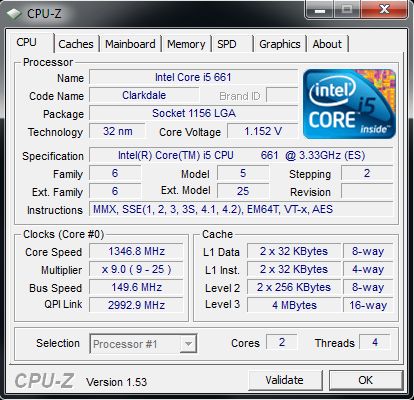
Maximum overclock @ stock voltages (3874MHz)
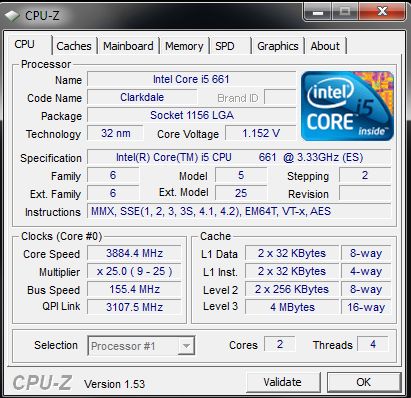
Maximum overclock @ stock voltages without Turbo
With increased core VID, speeds up to 4.3GHz are possible on the stock cooler:
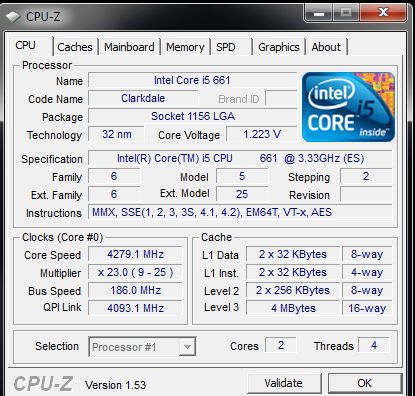
A 0.1V boost puts you in the 4.3GHz ballpark.
Watercooling
Clock for clock performance of Clarkdale against other platforms may not be impressive, but frequency scaling with good cooling is:

4853 MHz stable comes in with a processor load voltage of around 1.438V. Memory performance is related directly to the QPI link ratio. For best performance, keep the QPI link speed as close as possible to CPU core speed to minimize buffer hold times for lower memory access latency.
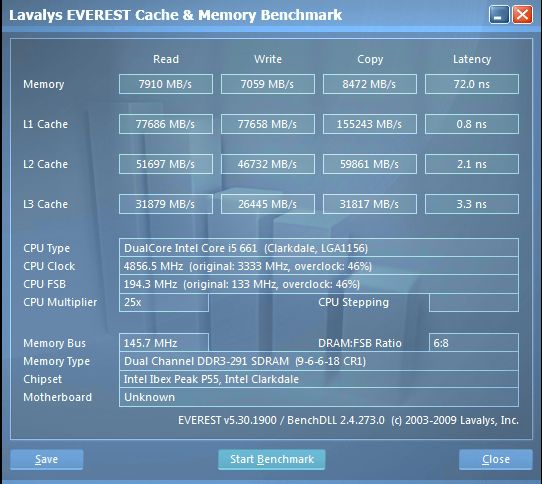
12X QPI Multiplier
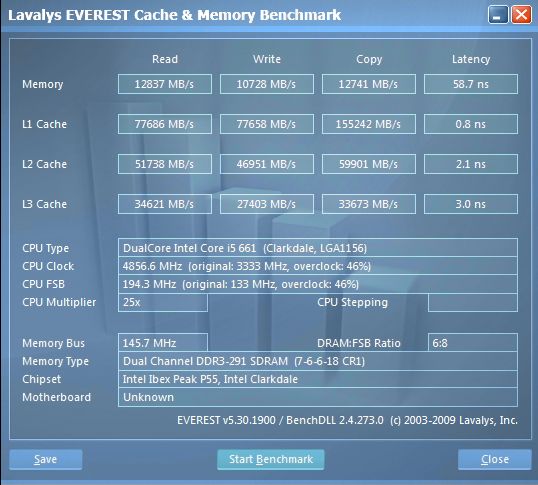
24X QPI Multi
The bandwidth figures are not stellar on either side of the scale (bear in mind the Everest bench DLL needs an update for Clarkdale). However, the higher QPI multiplier ratio is essentially free for the taking; requiring no additional IMC (VTT) voltage increase until BCLK is increased past 210 or so.
Like Lynnfield and Bloomfield, odd CPU multiplier ratios are more stable than even, although the disparity is less pronounced on Clarkdale. We found that even multipliers needed higher VCore at the same overall processor frequency or needed to be run at a lower overall overclock for stability. We’re not sure on the exact cause of this issue but it’s likely to be related to frequency synthesis within the CPU and downstream logic sampling.
Another caveat with Clarkdale overclocking is that the platform seems to be limited to memory speeds below 1600MHz as soon as you increase BCLK significantly (speeds over 1600Mhz are possible at stock BCLK). We’d hedge bets this is due to the memory controller relying on a preset DRAM clock skew table like Intel’s Front Side Bus architectures of old. The current DRAM frequency ceiling means that you’ll be shooting for CAS 5/6 capable memory between 1300-1600MHz for best performance with 4GB of RAM. 8GB configurations require a loose set of sub-timings, and also a 2N Command Rate to achieve 1600 MHz stable on our sample processor.
Sub-Zero
Bloomfield was hit and miss when it came to frequency scaling at low temperatures. Clarkdale seems to be a different animal altogether:
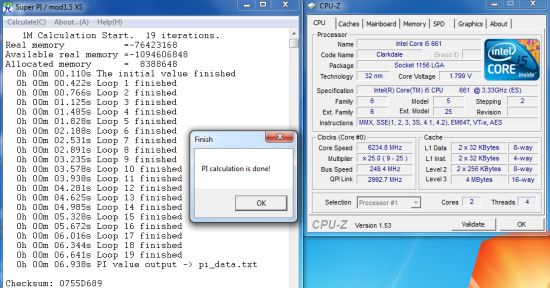
This is what ‘Clarkie’ is good at..
This screenshot was taken with our cascade cooling the CPU. Evaporator head temperatures were in the region of -115 Celsius. Most Lynnfield/Bloomfield CPUs were out of their comfort zone at these temperatures, but Clarkdale seems to be at home. You still get the occasional cold boot bug, but most of the ES CPUs will run benchmarks right down to the boiling point of LN2 (motherboard permitting). We’ve seen screenshots of 3D benchmarking above 6.5GHz and Super Pi runs edging close to 7GHz. Sounds great, but unfortunately, Super Pi 1M is the only benchmark where Clarkdale is really competitive. Once you’re past 230 BCLK, you have to leave QPI frequency on the floor which hurts memory performance in a big way. Couple that with the 1600MHz or so cap on DRAM frequency and you’ll understand why Super Pi 32m doesn’t fare so well on this platform. 3D performance in Futuremark’s 3DMark05 is just about competitive with the current ‘top’ Bloomfield results if you can run Clarkdale at 6.5GHz throughout the bench. The upshot is that we think there will be more good Clarkdale chips capable of 6.5GHz than there are Bloomfield CPUs that can run 3D benchmarks at 5.4GHz. The funny thing is that P55 motherboards using an NF200 to provide triple CrossFire/SLI might actually be the way to go for benchmarks like 3D Mark 05 if you’re into competitive benchmarking!
While Clarkdale may not be the fastest performer from Intel, it’s probably the most fun to overclock.










93 Comments
View All Comments
Anand Lal Shimpi - Monday, January 4, 2010 - link
You're very right, it appears to be a side effect of the ASUS H57 board looking at everyone else's results. I'm out in Vegas at CES now but I'll run some numbers on Intel's H55 when I return this weekend.Take care,
Anand
plonk420 - Monday, January 4, 2010 - link
this power consumption is a bit weird... i've actually done the same testpc power & cooling 750 watt
i7-920, ex58-ud3r, 3x1 DDR3, hd5870, 2 hdds, 3 fans, HT on
default voltage: 215 watts in p95 (122 watts idle, no powersave mode)
undervolted 1.125v: 187 watts in p95 (121 watts idle, no powersave mode)
default, 8600GT: 211 watts in p95 (116 watts idle, no powersave mode), 184 watts on "sane load" (distributed computing)
1.125v, 8600GT: 183 watts in p95 (115 watts idle, no powersave mode), 164 watts on "sane load" (distributed computing)
i7-860, ex-p55m-ud2, 4x1 DDR3, 5870, 2 hdds, 2 fans, HT on
default voltage: (either i lost results, or i never tested them)
undervolted 1.025v: 167 watts p95 (107 watts idle, 101 watts in power saver), 149 watts on enigma@home (8 instances)
Spoelie - Monday, January 4, 2010 - link
The Load Power Consumption on page 4 also raises questions.The Phenom system rises 90w to decode a x264 movie, while the clarkdale system only rises 20w. It seems to me that the clarkdale system had DXVA support on while the Phenom system had it off..
Can someone check/confirm this?
Anand Lal Shimpi - Monday, January 4, 2010 - link
I was caught off guard by it too but DXVA was enabled. I'm currently out in Vegas for CES but when I return I'll give it another look in our Core i3 review. I've had issues with power consumption being stuck at unusually high levels on AMD boards in the past, but I couldn't get this one to shake in time.Take care,
Anand
MrAwax - Monday, January 4, 2010 - link
HD Codec bitstreaming has been added in HDMI 1.3 specs at the receiver manufacturer request for no reason except that they did want to lose their market.Since HD codecs are LOSSLESS, decoding them in the player or in the receiver makes NO difference. And HDMI supports streaming of 8 uncompressed channels in LPCM @192kHz/24b since 1.0. So digitally, there is ZERO POINT ZERO difference. This is the reason it is useless. And this is the reason HDMI added 8 channels of high resolution audio so you won't need to upgrade your receiver !
And this is stupid because bitstreaming is a LIMITATION of feature, not an added feature. BluRay norm supports in player audio mixing. A lot of discs are already supporting it. The player can mix sounds live on the main soundtrack. This is useful for adding dynamic menu sounds or director/actor commentary. In theory, the disc could even have a single music/fx soundtrack and dynamically mix voice to support multiple langage and save space on disc (voice is generally stereo, is not always present and reencoding every time the music/fx is a waste of storage). With HDMI bitstreaming, you can stream the main track only. Gone is the menu fx sound, gone is the bonus commentary and gone is the voice.
Welcome to receiver manufacturer lobbying for USELESS and STUPID feature.
PS: on the contrary, 8 channels hires LPCM is a great feature.
salacious - Monday, January 4, 2010 - link
Bitstreaming does have the disadvantages of loosing audio track mixing but it does offer something.If the decoding is done in the PC were are relying it to not to downsample to 48kHz/16bit which happens unless you have the correct combination of player and audio card. If the decoding is done in the PC you are relying that it decodes to the correct speaker and I have found that with a 7.1 speaker setups this is a complete mess.
Also if you want to apply any receiver effects to the audio then over HDMI you tend to be limited. If the movie is 5.1 and it is EX encoded and you have a 6.1/7.1 speaker setup, then the usual solution is to apply this processing in the receiver but if you set your PC to 7.1 then it sends 2 blank audio channels and you can't apply EX processing. You have the same problem is you play back a surround encoded stereo track on a 5.1 speaker system, all that happens is that the audio is output from the left/right speakers and you are unable to apply pro-logic decoding to it.
A solution would be for the PC to offer Pro-logic IIx and other types of decoding but as they don't then you need the receivers to do it which means bitsreaming.
FlyTexas - Monday, January 4, 2010 - link
...Is this really needed?Ok, so more speed is good, I wouldn't turn it down... ...however anyone who uses computers in the office environment knows that CPUs have been "fast enough" for awhile now.
We currently have a dozen Dell Vostro 200's with Pentium Dual Core 1.6ghz CPUs, and a dozen Dell Vostro 220's with Pentium Dual Core 2.4ghz CPUs in the office (among a few other oddball machines and the server).
These computers run Office 2007, Adobe Acrobat 9, IE 8, etc. Some of them also run Quickbooks and a few other programs. None are used for video encoding, games, or anything that fancy.
You know what? The difference between the 1.6ghz machines and the 2.4ghz machines isn't all that noticeable, once everything is up and running (they all have 2GB of RAM, running Windows XP Pro SP3). They all have the Intel GMA graphics, and for the office, they are all plenty fast.
Why would our company upgrade to these new CPUs?
The Pentium Dual Core CPUs were a nice jump over the Pentium 4 line. (we used to have all Pentium 4 machines back in 2006) This new line of CPUs doesn't seem like the same kind of improvement.
tomaccogoats - Monday, January 4, 2010 - link
I only look at new cpu's for gaming :plowlight - Monday, January 4, 2010 - link
You might notice a difference if they were running Windows 7 with 4GB of ram. Right now they are all a bit bottlenecked by the OS (poor multitasking performance) and low amount of RAM.But in general I agree with what you're saying.
FlyTexas - Monday, January 4, 2010 - link
I have Windows 7 installed on my computers at home, I haven't moved the office machines due to a lack of any good reason to do so.We have Windows 2003 R2 Small Business Server at work. Everyone is on user accounts on a domain. We have a hardware firewall running as well as the usual antivirus/spam/etc. stuff running.
It all just works, I have no desire to rip it all apart, spend a lot of the company's money, to gain... well I'm not sure what we'd gain. If I can't think of a good reason to do it, I sure can't sell it to the boss.
This isn't a knock against Microsoft, I personally love Windows 7, it is great for my home computer, but it doesn't do anything for the work computers. In a larger company, I can see the benefits of moving to it (and Server 2008), but we just don't have that large of a network (or budget).
As a side note: You wouldn't have wanted to see the mess that was here when I got here, it was all running on a wireless linksys router on an unencrypted network. I managed to get the office wired with gigabit ethernet and turn off the wireless. Got a good server in place, setup a Dell account, and moved out most of the oddball machines (we did two lease purchases of machines, one for each dozen of the Vostros, got a heck of a deal on them too). Of course I sold this to the boss by saying that it would all last at least 5 years, and we're about 2 years into that 5 year plan. :)
Maybe we'll just skip Windows 7 and move to 8 when it comes out.